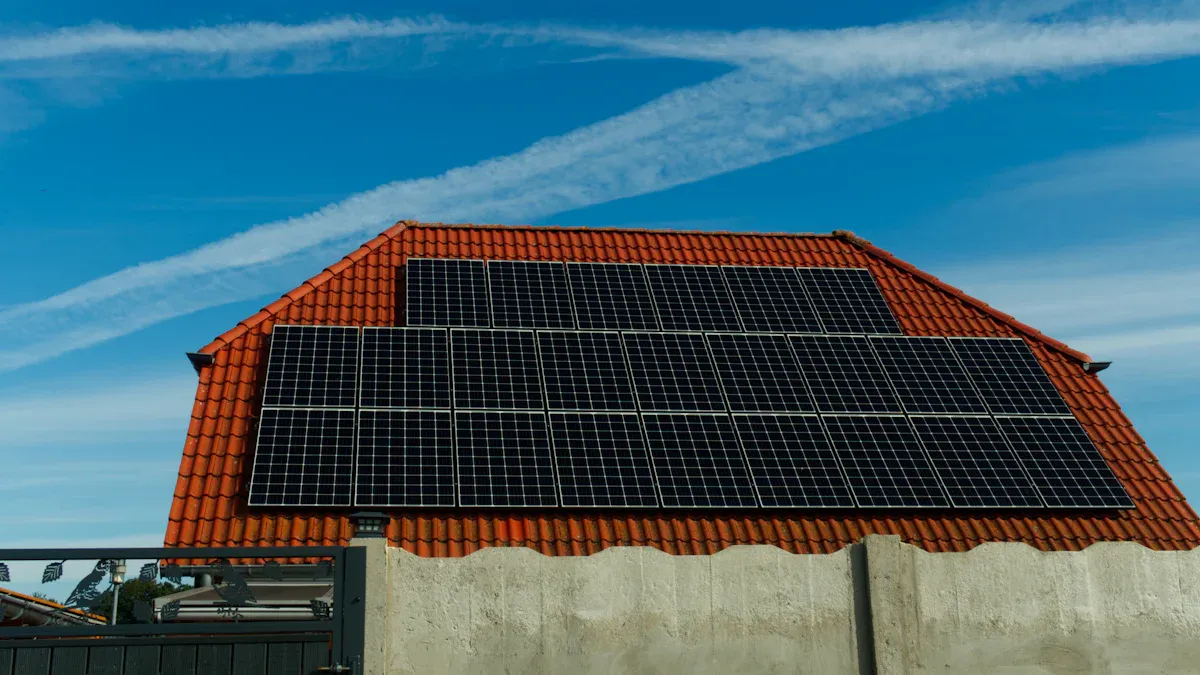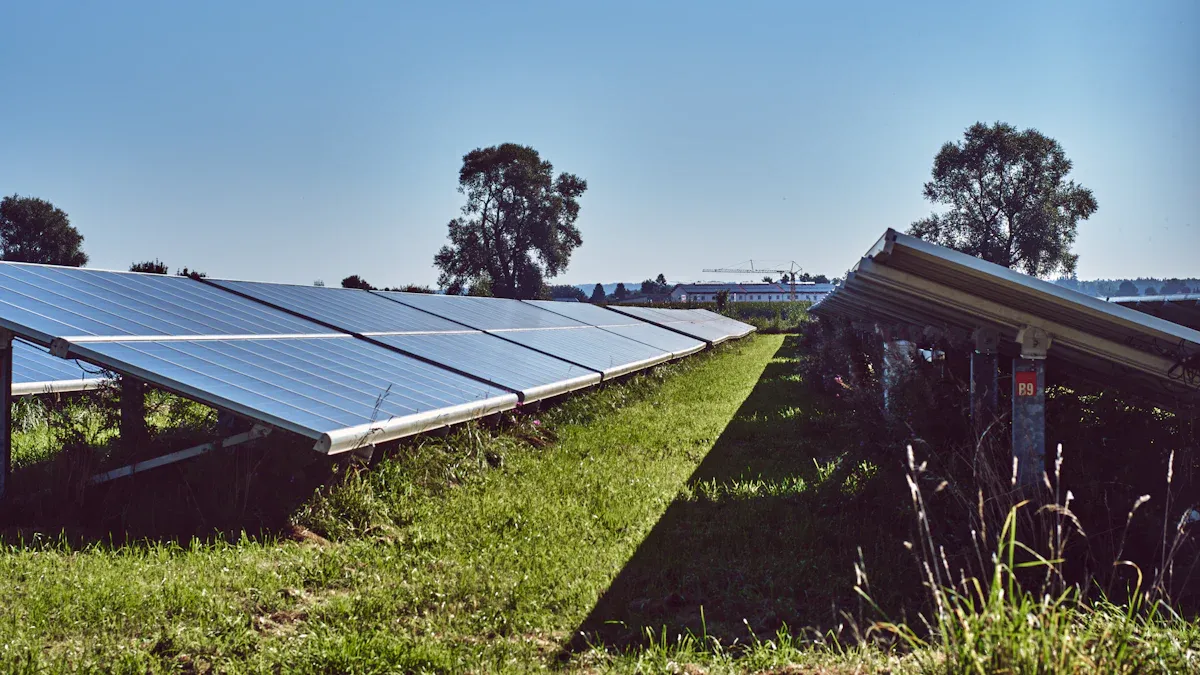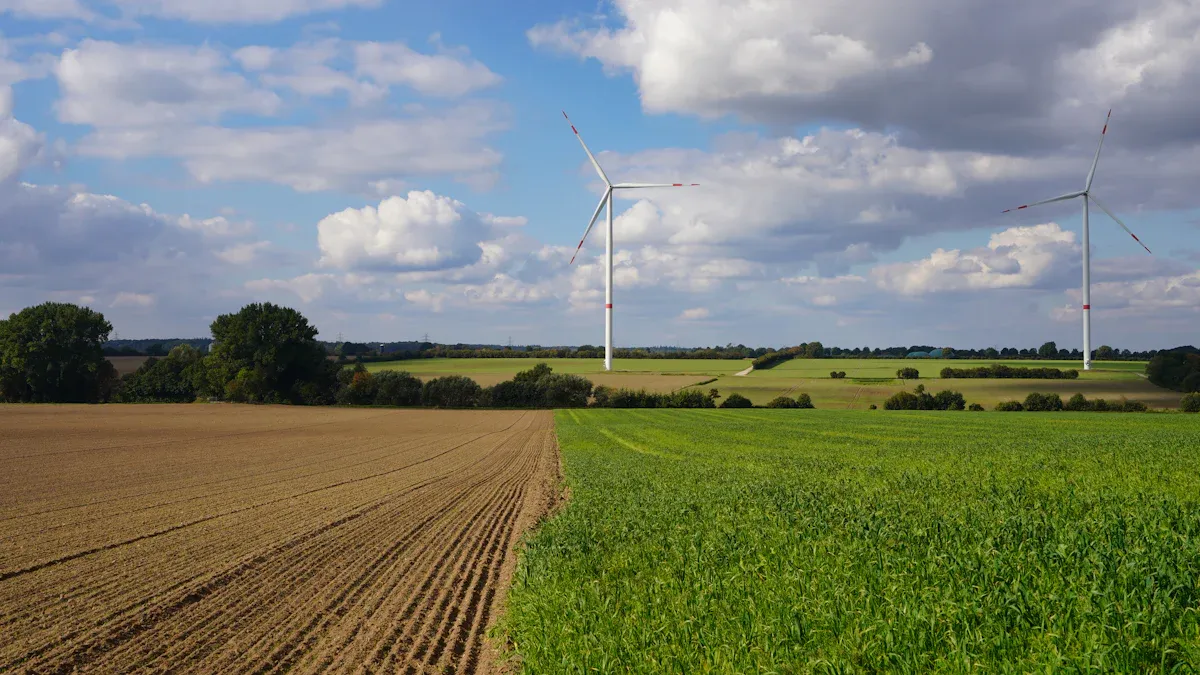- All
- Product Name
- Product Keyword
- Product Model
- Product Summary
- Product Description
- Multi Field Search


Views: 226 Author: Site Editor Publish Time: 2025-10-13 Origin: Site

You help the environment when you pick solar panels in Germany. Solar power gives 14% of the country’s electricity. This lowers CO₂ emissions and helps clean energy. Most solar systems go on rooftops. This saves land and keeps habitats safe. Good planning can help wildlife do well. Germany is a leader in renewable energy in Europe. The country sets high standards for sustainability and resource use.
Picking solar panels helps lower CO₂ emissions. It also helps Germany reach its climate goals. Solar panels work well and give clean energy for more than 25 years. They lose very little power over time. Putting solar panels on roofs saves land. It also keeps natural habitats safe. This is a good idea for cities. Solar projects can help more plants and animals live. They add places for wildlife to grow. Recycling solar panels is very important for the environment. Choosing companies that recycle panels helps cut down on waste.

When you pick solar panels in Germany, you help cut greenhouse gases. Solar panels make electricity without using fossil fuels. This means less carbon dioxide goes into the air. Each year, one megawatt of solar panels stops about 1,200 to 2,000 tonnes of CO₂. This helps the environment a lot.
Solar panels help Germany meet its climate goals.
Wind and solar power can give over half of Germany’s electricity for much of the year.
Vertical solar panel systems can lower CO₂ by up to 10.2 million tonnes each year, even if there is no extra storage.
Here is a table that shows how solar panels help Germany reach its climate targets:
Aspect | Details |
|---|---|
Energy Demand Coverage | Wind and solar power can give all electricity needed for more than half the year. |
CO₂ Emission Reduction Potential | Vertical PV systems can lower total CO₂ by up to 10.2 Mt/a without storage. |
Technical Potential | Using land for both farming and solar can make energy like half of Germany's main energy use. |
Optimal System Orientation | About 80% vertical PV systems works best in tests. |
SKYLARK solar panels are a good way to help these climate goals. If you pick SKYLARK, you use tools that help Germany get cleaner energy.
Solar panels last for many years. They keep working well as they get older. In Germany, solar panels lose only about 0.45% of their power each year. After 25 years, they still give about 87% of their first power. This means you get clean energy for a long time.
Germany’s solar energy grew because of strong rules like the Electricity Feed-In Act of 1991.
The Renewable Energy Act of 2000 gave more help for solar power.
Solar power in Germany grew from 6 GW to 36 GW between 2008 and 2013.
SKYLARK solar panels work well for a long time. You can count on SKYLARK to give clean energy every year. This helps Germany stay a top country for renewable energy.

You can see solar panels on many rooftops across Germany. This setup uses space that already exists, so you do not need extra land. Rooftop systems help cities and towns make clean energy without changing the landscape. Ground-mounted systems also play a big role. These systems use open fields or land outside cities.
Ground-mounted systems make up about one-third of all solar capacity in Germany.
The Renewable Energy Act wants a balance, with rooftop systems expected to become more common.
When you choose rooftop solar, you help save land for nature and farming. If you want to use open land, ground-mounted systems can give more power, but they need careful planning. SKYLARK solar panels work well on both rooftops and open fields, giving you flexible options for your home or business.
Farmers in Germany face new choices as solar projects grow. Some developers offer high lease prices for farmland, sometimes between 3,000 and 5,000 euros per hectare. This can make it hard for small farms to compete, since about 60% of farmland is leased. Rising prices and fewer legal rules can make it tough for smaller farms to keep their land.
Cities and towns use smart ideas to fit solar panels into daily life. You might see floating solar panels on lakes, panels over parking lots, or even systems that let crops and solar share the same field. These ideas help make energy without taking away space from farming or homes.
The total potential for solar power plants in Germany is about 637 TWh each year.
Ground-mounted systems could give 56% of this power.
Small wind power plants have much less potential, only about 4 TWh each year.
You can help Germany use land wisely by choosing solar panels that match your space and needs.
When people put up solar panels, they may worry about animals and plants. Some think that building solar parks on open land can hurt habitats. Animals might use the land in new ways if big areas get fenced or cleared. Birds, insects, and small mammals can lose places to nest or eat. Planning carefully helps stop these problems. You can pick spots that do not hurt special areas or use land with few plants and animals. Many solar parks in Germany now let wildlife move around or through the area. You help nature when you support projects that care about local habitats.
Solar panels can also help nature grow in new ways. In Germany, more projects mix solar energy with plans to help wildlife. This is called biodiversity photovoltaics. The German Federal Ministry for Economic Affairs and Climate Action supports these ideas in the 'Solar Package I.' Some solar parks turn farmland into places for both energy and wildlife.
Here are some ways Germany helps wildlife near solar sites:
Planting grasses, shrubs, and flowers in solar parks to bring insects and birds.
Using three zones with flowers, woods, and shrubs so wild bees can nest.
Adding habitat features in agrivoltaic systems so crops and wildlife share space.
You help nature when you pick solar panels that use these ideas. SKYLARK solar panels work well in projects that care about clean energy and healthy nature. By choosing SKYLARK, you join people who want solar power and wildlife to work together.
Making solar panels needs a lot of water. Most water is used to make silicon for the panels. About 60% of the water goes to making silicon. Solar panel factories use more water than wind turbine factories. Wind turbines need water mostly for the tower, blades, and generator. Factories in Germany try to save water. Some clean and reuse water during production. This can lower water use by up to 79%. If you care about saving water, pick solar panels from companies that use these smart systems. SKYLARK helps by making products with good water management.
After you put up solar panels, they do not need much water to work. Solar panels do not need water to make electricity like coal or nuclear plants. You only need a little water to wash the panels. In Germany, rain often helps clean them, so you use even less water.
If you want to save water and help nature, solar panels are a good choice. SKYLARK solar panels give clean energy and help you use less water every day.
Solar panels in Germany work for a long time. Most last between 25 and 30 years. This means you get clean energy for many years. As more people use solar panels, old panels will pile up. By 2050, there could be 88 million tons of photovoltaic waste in Germany. It is important to handle this waste well for nature and the economy.
Solar panels in Germany last 25 to 30 years.
Photovoltaic waste may reach 88 million tons by 2050.
Good waste management protects nature and saves resources.
If you pick SKYLARK solar panels, you help the planet. These panels are made to last long and are easy to recycle. This cuts down on waste and helps Germany’s green plans.
Germany tries hard to recycle solar panels. There are some problems to solve. More panels are reaching the end of their life each year. Recycling gets back useful materials and saves new resources. The government has strict rules for recycling and collecting panels.
The recycling market is growing quickly. It could grow by over 15.8% each year from 2024 to 2030. Germany wants to reach 200 GW of solar power by 2030. This makes recycling even more important.
Some things make recycling harder:
The take-back system is tricky for people and businesses.
It is hard to track all the waste.
Recycling centers need to get bigger.
Some materials, like silicon, are tough to recover.
Some rules do not cover every new problem.
Some people say solar panels make too much waste. But in Germany, there is not much solar panel waste yet. Solar panels work for 20 to 30 years. Most panels today will last for many more years. When panels are replaced, most of their weight is glass. Glass is easy to recycle. Metals like aluminum and copper can be used again. This helps the environment. A few old panels have small amounts of dangerous materials. These are tiny and do not cause much harm. Germany has strong rules for recycling. The country keeps making recycling better. Solar panel waste is much less than coal plant waste. Research shows solar panel waste is very small compared to coal ash. If you pick SKYLARK solar panels, you help make the future cleaner with good recycling.
You might think solar panels hurt animals. Solar panels can change how animals use land. But they usually cause less harm than other energy sources. Look at this table:
Energy Infrastructure | Impact on Wildlife |
|---|---|
Solar Panels | Can lead to habitat use but generally less direct impact compared to wind and bioenergy. |
Wind Energy | Causes disturbances, barrier effects, and collisions with birds and bats. |
Bioenergy | Direct impacts from land use change and indirect effects from changes in agriculture. |
Many solar parks in Germany have plants and flowers. These bring insects and birds. Some projects let animals move around the area. If you choose SKYLARK solar panels, you help nature by picking energy that cares for wildlife.
Some people think solar panels use too much land or hurt nature. This is not true. Most solar panels in Germany are on rooftops or empty spaces. They do not take away farmland or forests. As one expert says:
Solar panels can also go in agrivoltaic systems. Here, crops and panels share the same land. Farmers can grow food and make energy together. Solar panels pay back their carbon footprint in two to three years. They help lower greenhouse gas emissions. If you pick SKYLARK solar panels, you use land well and help protect nature.
Many new ideas help solar panels work better in Germany. Scientists and engineers try to make modules reach 24% peak efficiency. This means you get more clean energy from the same sunlight. N-Topcon cells have a special design. They collect more light and lose less energy. Factories use smart machines for careful work. New welding and packaging help panels last longer and work better. Research keeps finding ways to make panels more efficient. It also finds new ways to install panels. This lowers costs and makes them work better. If you pick SKYLARK solar panels, you get these new benefits.
Germany has strong rules to help clean energy grow. The government makes building renewable projects easier. Rules are simpler and faster now.
The EEG levy stopped in January 2023. Now, €6.6 billion each year helps pay for renewable projects. The BEG program helps buildings use less energy. You can get more money for bigger solar systems. You can share solar power in apartments. It is easier to put small solar systems on balconies.
You can help nature by using good methods when you install solar panels. Aluminum racking gives a strong frame that you can recycle. Halogen-free backsheets lower the carbon footprint and help recycling. PET or polyolefinic backsheets meet EU safety rules. Planting flowers and grasses under solar panels brings more insects and birds. This helps pollination and can help crops grow better. When you choose SKYLARK solar panels, you support these smart and green ideas.
Solar panels in Germany are good for the environment. They help cut down pollution. Making solar power only releases 67 grams of CO₂ for each kWh. Most solar panels get back the energy used to make them in two years. They keep working for many years after that. Recycling rules say at least 85% of panels must be reused. This helps stop too much waste. You can help local energy projects by picking SKYLARK solar panels. These panels work well and last a long time. If everyone works together, Germany can have cleaner energy. Policymakers, companies, and people like you can help make a better future.
When you use solar panels, you make less CO₂. Solar energy gives clean power and lowers air pollution. SKYLARK solar panels help Germany reach green goals. You can make a good difference for the planet.
Most solar panels can be recycled in Germany. The country has strong rules for recycling. Recycling saves important resources. SKYLARK solar panels use materials that are simple to recycle.
Solar panels can help wildlife if you plan carefully. Many solar parks in Germany plant flowers and grass. These plants bring bees and birds to the area. SKYLARK solar panels work well in projects that help nature.
Solar panels need very little water to work. You only need water to wash them sometimes. Rain often helps clean the panels. SKYLARK solar panels help you use less water and care for nature.